Building soil and soil fertility is so much more than just adding compost and NPK. Compost does build organic matter in the form of stable humus but doesn’t contain the optimum quantities of minerals, and NPK does provide a tremendous growth/bulk response but only provides three minerals — Nitrogen, Phosphorous, and Potassium. How do the other minerals we need get into the food we grow?
Over decades, we’ve come to understand that the human body needs a large blend of minerals to function in the healthiest way possible and to resist disease. Look at the label on your multi-vitamin supplement. You’ll see Calcium, Magnesium, Potassium, Boron, Iron, Manganese, Copper, Zinc, and a host of others. For a maximum benefit to our bodies, it’s far better to get those through food we ingest, not a supplement. And, if it’s not in our soil, it can’t be in our food.
For crops to reach their full genetic potential and contain optimum levels of the other minerals we need, and taste as good as we want, these minerals must be in the soil at optimum levels. Vegetables and fruits will have greater sweetness and taste due to the phytonutrients that are manufactured by the crop. For any living thing to produce phytonutrients, proteins, enzymes, or amino acids, mineral elements much be present to act as catalysts. Just as an example, over 300 enzymes in the human body require Zinc as a catalyst.
A healthy, vigorous, nutrient-dense crop also has much greater disease and pest resistance.
Time and space do not permit an analysis of each mineral function. They are interdependent, and a shortage of any one of them can adversely affect crop yield and quality. Here are a couple of examples:
- Calcium directly stimulates the uptake of seven other minerals. So, a shortage or an excess of Calcium will affect cell strength and cell division which in turn will affect crop resilience, flowering, and fruit development.
- Magnesium deficiency will reduce phosphate uptake. Since phosphate drives all stages of the plant cycle, the result will be poor, early root growth and poor seed and fruit development.
The best way to illustrate this is through the “Law of the Maximum.” An excess of one mineral will result in the shortage of another. A crop may show signs of Potassium deficiency when in fact there is plenty of Potassium, but an excess of another mineral is limiting the uptake of Potassium. If one adds Potassium in this case, without a soil test, then it will throw Potassium out of balance along with reducing the uptake of other minerals.
All of this shows that minerals in the soil are the source of soil fertility and therefore crop quality and yield. Building the soil and balancing the minerals, stimulates the activity of beneficial soil bacteria, microbes, and fungi. This increased biological activity is what makes the minerals more and more available to the plant.
Indeed, building the soil requires the addition of organic matter/compost and biological activators, but it is not the end all. 10% Organic Matter in the form of stable humus will provide enough Nitrogen throughout the growing season for most crops. Sulfur, Phosphorous, Calcium, Magnesium, Potassium, Sodium, Boron, Iron, Manganese, Copper, and Zinc must all be present and in ideal balance to each other. Silicon, Molybdenum, Cobalt, and Selenium are important trace minerals that act as synergists. Building the soil also means building “reserves.” Once the soil is brought into optimum mineral balance, the pH will self-adjust to around 6.4 and you will have the reserves to provide soil balance for many years to come. Boron and Sulfur will require yearly maintenance as they are readily taken up by crops.
A word about Phosphorous. To maintain organic certification, or to simply grow organically, there are two readily available sources of Phosphorous approved for organic use by the USDA National Organic Program. Tennessee Brown Phosphate (TBP) and Calphos brand colloidal clay phosphate from Florida. TBP is 10% elemental Phosphorous while Calphos is 9% elemental Phosphorous. We prefer to use TBP as it contains a vast array of important trace minerals such as Cobalt, Molybdenum, and Selenium as well as well a host of others.
Most soils are considerably Phosphorous deficient and the amount of TBP required to balance the soil can cause skepticism. Let’s say we need 80 ppm or 160#/acre of elemental Phosphorous. Since TBP is 10% elemental Phosphorous, we would need to add 1,600#/acre of TBP (160 / 0.10 = 1,600). So, when we suggest adding 1,600#/acre of TBP, an organic farmer may walk away without saying another word (and we’ve had that happen). That amount is by far much more than anything they’ve ever heard of. But we must remember, TBP is only 10% elemental Phosphorous and we are also “building Phosphorous reserves” for many years to come and adding a vast array of vital trace minerals needed in very small quantities. For the home gardener with a 1000 ft.2 garden, this translates to 37#/1000 ft.2 of TBP.
One can split the application over three years (533#/acre each year or 12#/1000 ft.2 per year for the home gardener with 1000 ft.2 of garden space). You may not get the same results in the first year, but they will be far better than a Phosphorous deficient soil.
What is important to remember when you are skeptical about the quantities of minerals needed to balance the soil, is that you are “building the soil” and its fertility for many years to come.
In Part 2, we’ll explore the importance, function, and sources of trace minerals needed only in very small amounts — Cobalt, Molybdenum, Selenium, and Silicon — and the vital role they play in soil fertility.


